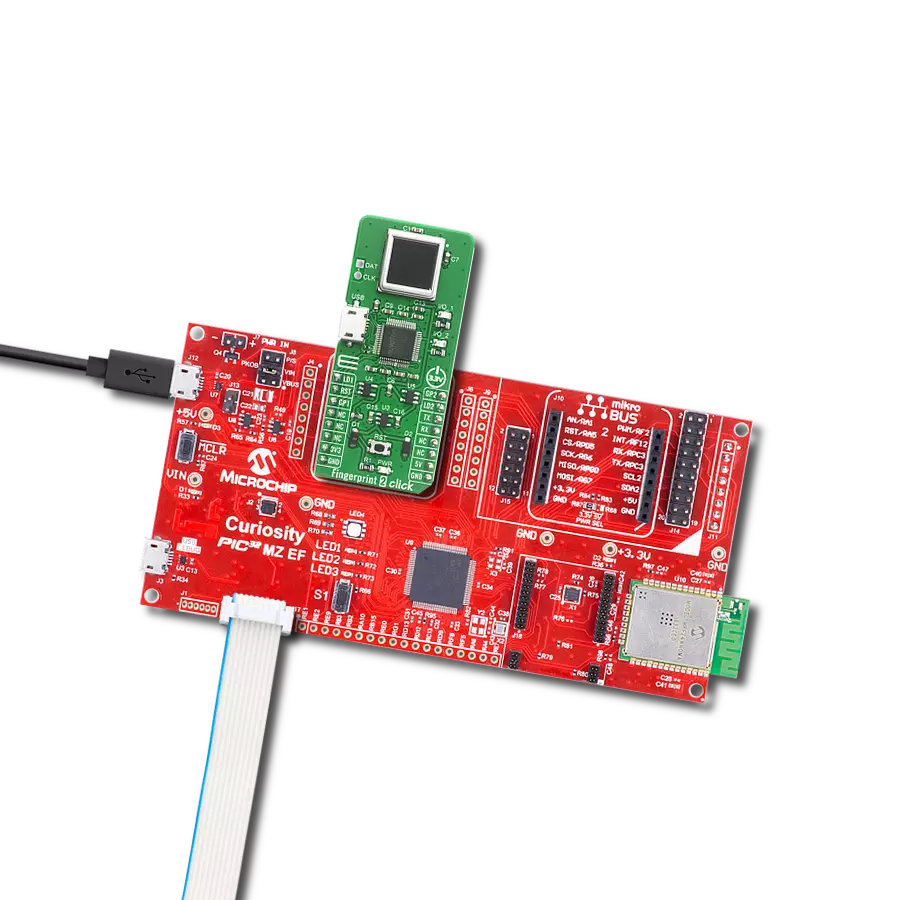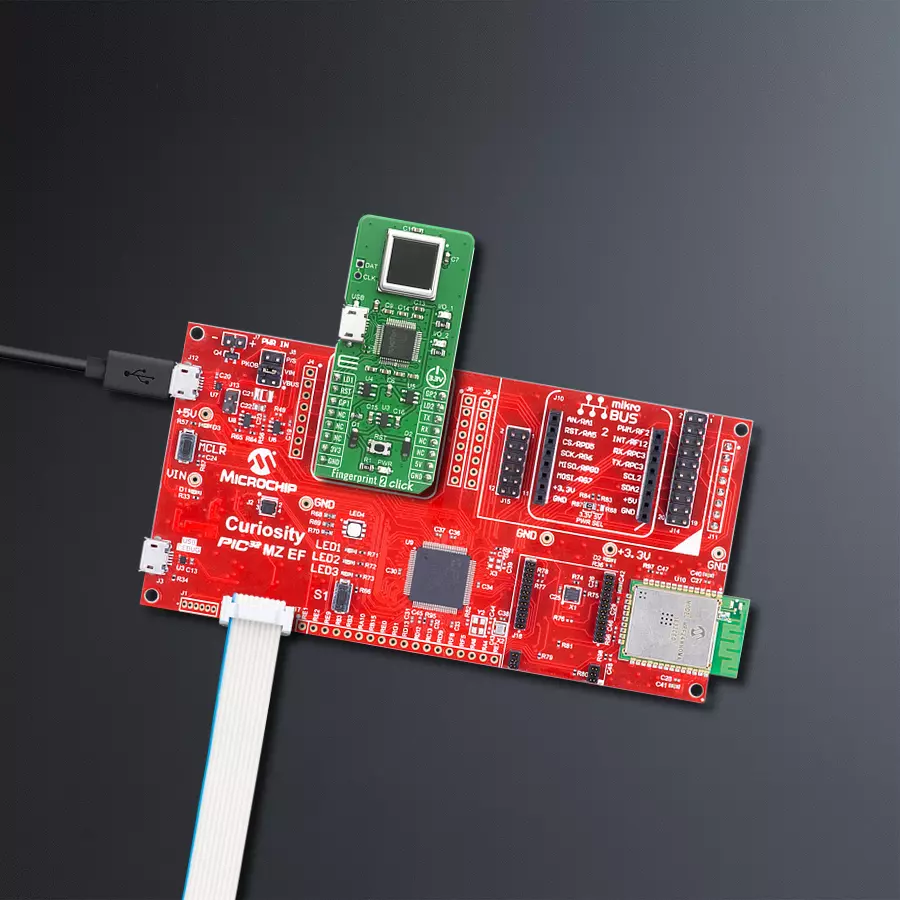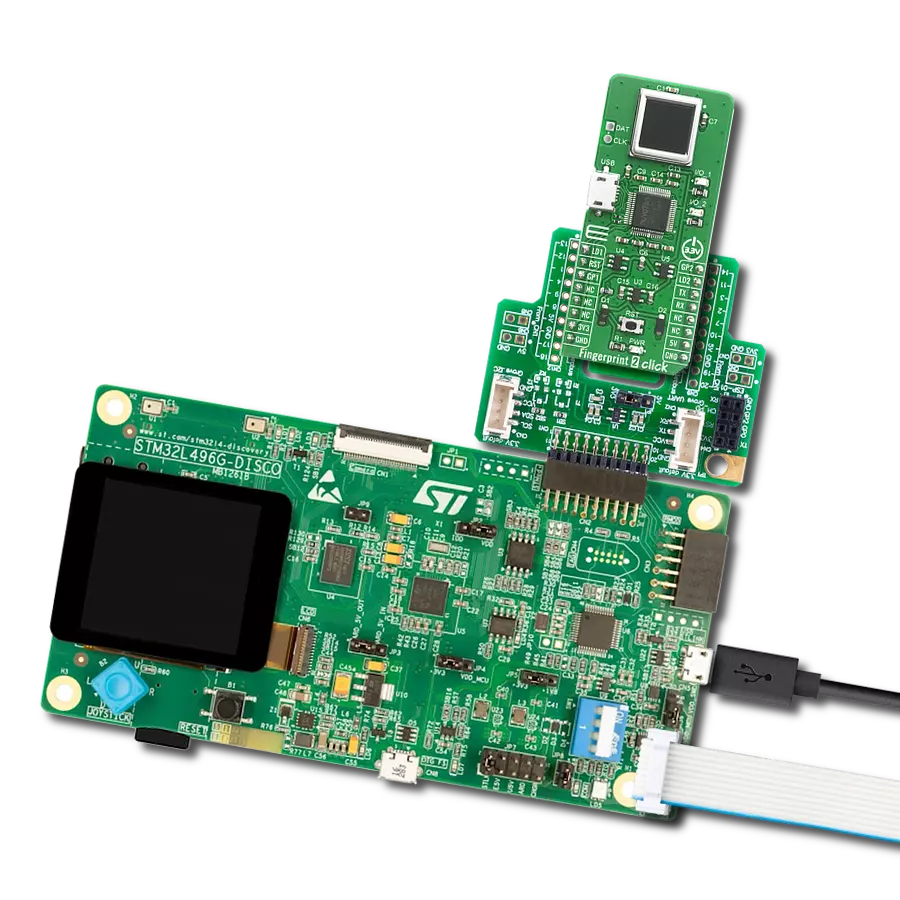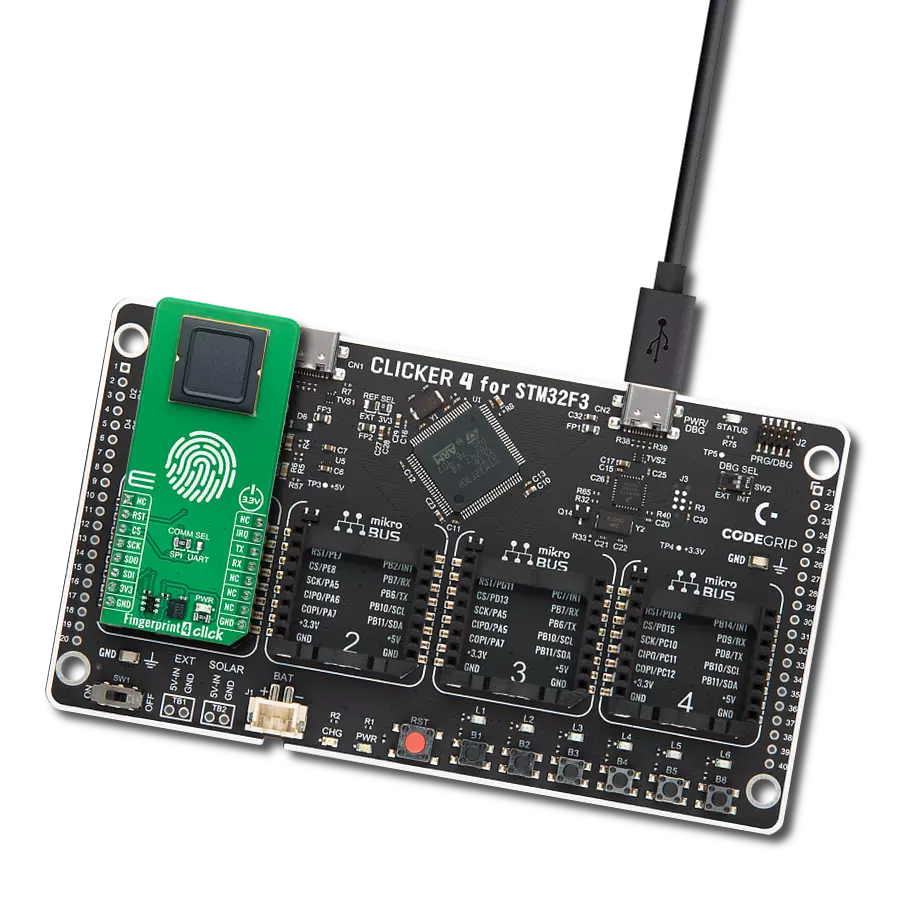Implement biometric fingerprint recognition and enable accurate and unique identification of individuals for secure access to digital systems and physical spaces
A
A
Hardware Overview
How does it work?
Fingerprint 2 Click is based on the A-172-MRQ, a 2D capacitive fingerprint sensor from ByNew Technology with an active scanning area of 8.8 x 8x8 mm and a 176 x 176 pixels resolution. The sensor is based on capacitive-contact technology with a hardened surface and enhanced ESD immunity. On board, Nuvoton M2301 MCU, which serves as interface IC and control unit, interfaces this sensor over a high-speed SPI interface and comes with built-in fingerprint matching capability while leaving most of the chip resource to application developers. Developers can develop fingerprint-related products based on the
communication protocol without advanced knowledge of fingerprint identification. The Fingerprint 2 Click has stable performance and a simple structure. The simplified functions for faster and easy development include fingerprint comparison, image scanning transmission, search, registered fingerprint storage, and the system's unique internal code protection mechanism. The fingerprint comparison program can register at most 24 fingerprints, the comparison speed is fast, and the correct rate is very high. Thanks to the Nuvoton MCU with the on-chip crypto-accelerator, Cortex-M23 TrustZone, and XOM facilities that
communicate with the fingerprint sensor and provide information to the host, the Fingerprint 2 Click board can be interfaced with commands over UART protocol (baud rate 115200) or USB 2.0 full speed. Fingerprint 2 Click needs to be supplied with 3.3V and 5V for proper operation. However, note that this board is designed to be operated only with 3.3V logic levels. Therefore a proper logic voltage level conversion should be performed before the Click board™ is used with MCUs with logic levels of 5V.
Features overview
Development board
Curiosity PIC32 MZ EF development board is a fully integrated 32-bit development platform featuring the high-performance PIC32MZ EF Series (PIC32MZ2048EFM) that has a 2MB Flash, 512KB RAM, integrated FPU, Crypto accelerator, and excellent connectivity options. It includes an integrated programmer and debugger, requiring no additional hardware. Users can expand
functionality through MIKROE mikroBUS™ Click™ adapter boards, add Ethernet connectivity with the Microchip PHY daughter board, add WiFi connectivity capability using the Microchip expansions boards, and add audio input and output capability with Microchip audio daughter boards. These boards are fully integrated into PIC32’s powerful software framework, MPLAB Harmony,
which provides a flexible and modular interface to application development a rich set of inter-operable software stacks (TCP-IP, USB), and easy-to-use features. The Curiosity PIC32 MZ EF development board offers expansion capabilities making it an excellent choice for a rapid prototyping board in Connectivity, IOT, and general-purpose applications.
Microcontroller Overview
MCU Card / MCU

Architecture
PIC32
MCU Memory (KB)
2048
Silicon Vendor
Microchip
Pin count
100
RAM (Bytes)
524288
Used MCU Pins
mikroBUS™ mapper
Take a closer look
Click board™ Schematic

Step by step
Project assembly
Track your results in real time
Application Output
1. Application Output - In Debug mode, the 'Application Output' window enables real-time data monitoring, offering direct insight into execution results. Ensure proper data display by configuring the environment correctly using the provided tutorial.

2. UART Terminal - Use the UART Terminal to monitor data transmission via a USB to UART converter, allowing direct communication between the Click board™ and your development system. Configure the baud rate and other serial settings according to your project's requirements to ensure proper functionality. For step-by-step setup instructions, refer to the provided tutorial.

3. Plot Output - The Plot feature offers a powerful way to visualize real-time sensor data, enabling trend analysis, debugging, and comparison of multiple data points. To set it up correctly, follow the provided tutorial, which includes a step-by-step example of using the Plot feature to display Click board™ readings. To use the Plot feature in your code, use the function: plot(*insert_graph_name*, variable_name);. This is a general format, and it is up to the user to replace 'insert_graph_name' with the actual graph name and 'variable_name' with the parameter to be displayed.

Software Support
Library Description
This library contains API for Fingerprint 2 Click driver.
Key functions:
fingerprint2_reg_one_fp- This function registrates fingerprint on indexfingerprint2_delete_one_fp- This function deletes fingerprint on indexfingerprint2_reset- This function restarts device
Open Source
Code example
The complete application code and a ready-to-use project are available through the NECTO Studio Package Manager for direct installation in the NECTO Studio. The application code can also be found on the MIKROE GitHub account.
/*!
* \file
* \brief Fingerprint2 Click example
*
* # Description
* This example demonstrates the use of Fingerprint 2 Click board.
*
* The demo application is composed of two sections :
*
* ## Application Init
* Initializes the driver, enables the Click board, and then executes a command for
* registering a fingerprint.
*
* ## Application Task
* Compares a fingerprint on input to the registered fingerprint and
* displays the results on the USB UART every 5 seconds.
*
* ## Additional Functions
* - fingerprint2_process ( ) - The general process of collecting data the module sends.
* - fp_reg_one ( uint8_t fngr_number ) - Registers a fingerprint at a specific index number.
* - fp_clr_one ( uint8_t fngr_number ) - Deletes a fingerprint from a specific index number.
* - fp_clr_all ( ) - Clears all fingerprints.
* - fp_curr_state ( ) - Lists the registration status and returns the number of registered fingerprints.
* - fp_compare ( ) - Compares a fingerprint on input to all other fingerprints that are memorized.
*
* @note
* In the registration state each fingerprint needs to be enrolled 3 times.
*
* \author MikroE Team
*
*/
// ------------------------------------------------------------------- INCLUDES
#include "board.h"
#include "log.h"
#include "fingerprint2.h"
#include "string.h"
#define PROCESS_COUNTER 100
#define PROCESS_RX_BUFFER_SIZE 800
// ------------------------------------------------------------------ VARIABLES
static fingerprint2_t fingerprint2;
static log_t logger;
uint8_t flag;
// ------------------------------------------------------- ADDITIONAL FUNCTIONS
static void fingerprint2_process ( void )
{
int32_t rsp_size;
uint8_t check_buf_cnt;
uint8_t process_cnt = PROCESS_COUNTER;
char uart_rx_buffer[ PROCESS_RX_BUFFER_SIZE ] = { 0 };
flag = 0;
while( process_cnt != 0 )
{
rsp_size = fingerprint2_generic_read( &fingerprint2, &uart_rx_buffer, PROCESS_RX_BUFFER_SIZE );
if ( rsp_size > 0 )
{
// Validation of the received data
for ( check_buf_cnt = 0; check_buf_cnt < rsp_size; check_buf_cnt++ )
{
if ( uart_rx_buffer[ check_buf_cnt ] == 0 )
{
uart_rx_buffer[ check_buf_cnt ] = 13;
}
}
log_printf( &logger, "%s", uart_rx_buffer );
if ( strstr( uart_rx_buffer, "</R>" ) )
{
flag = 1;
process_cnt = 5;
}
// Clear RX buffer
memset( uart_rx_buffer, 0, PROCESS_RX_BUFFER_SIZE );
}
else
{
process_cnt--;
// Process delay
Delay_100ms( );
}
}
}
//Write index number of fingeprint to be store: from 0 to 23
void fp_reg_one ( uint8_t fngr_number )
{
log_printf( &logger, "Registration process\r\n" );
Delay_ms ( 500 );
fingerprint2_reg_one_fp( &fingerprint2, fngr_number );
do
{
fingerprint2_process( );
}
while ( flag == 0 );
}
// Write index number of fingeprint to be deleted: from 0 to 23
void fp_clr_one ( uint8_t fngr_number )
{
log_printf( &logger, "Deleting process\r\n" );
Delay_ms ( 500 );
fingerprint2_delete_one_fp( &fingerprint2, fngr_number );
do
{
fingerprint2_process( );
}
while ( flag == 0 );
}
// Delete all fingeprints: from 0 to 23
void fp_clr_all ( )
{
uint8_t cnt = 0;
log_printf( &logger, "Process of deleting all fingeprints\r\n" );
Delay_ms ( 500 );
while ( cnt < 23 )
{
fingerprint2_delete_one_fp( &fingerprint2, cnt );
cnt++;
do
{
fingerprint2_process( );
}
while ( flag == 0 );
}
}
// Current state ( number of memorized fingerprints )
void fp_curr_state ( )
{
fingerprint2_generic_write( &fingerprint2, FINGERPRINT2_CMD_FP_REG_NO, strlen( FINGERPRINT2_CMD_FP_REG_NO ) );
do
{
fingerprint2_process( );
}
while ( flag == 0 );
}
// Compare fingerprint on input with all other fingerprints that are memorized.
void fp_compare ( )
{
fingerprint2_generic_write( &fingerprint2, FINGERPRINT2_CMD_FP_CMP, strlen( FINGERPRINT2_CMD_FP_CMP ) );
fingerprint2_process( );
do
{
fingerprint2_process( );
}
while ( flag == 0 );
}
// ------------------------------------------------------ APPLICATION FUNCTIONS
void application_init ( void )
{
log_cfg_t log_cfg;
fingerprint2_cfg_t cfg;
/**
* Logger initialization.
* Default baud rate: 115200
* Default log level: LOG_LEVEL_DEBUG
* @note If USB_UART_RX and USB_UART_TX
* are defined as HAL_PIN_NC, you will
* need to define them manually for log to work.
* See @b LOG_MAP_USB_UART macro definition for detailed explanation.
*/
LOG_MAP_USB_UART( log_cfg );
log_init( &logger, &log_cfg );
log_info( &logger, "---- Application Init ----" );
// Click initialization.
fingerprint2_cfg_setup( &cfg );
FINGERPRINT2_MAP_MIKROBUS( cfg, MIKROBUS_1 );
fingerprint2_init( &fingerprint2, &cfg );
fingerprint2_reset ( &fingerprint2 );
Delay_ms ( 1000 );
fp_reg_one( 0 );
Delay_ms ( 1000 );
}
void application_task ( void )
{
fp_compare( );
Delay_ms ( 1000 );
Delay_ms ( 1000 );
Delay_ms ( 1000 );
Delay_ms ( 1000 );
Delay_ms ( 1000 );
}
int main ( void )
{
/* Do not remove this line or clock might not be set correctly. */
#ifdef PREINIT_SUPPORTED
preinit();
#endif
application_init( );
for ( ; ; )
{
application_task( );
}
return 0;
}
// ------------------------------------------------------------------------ END
Additional Support
Resources
Category:Fingerprint































